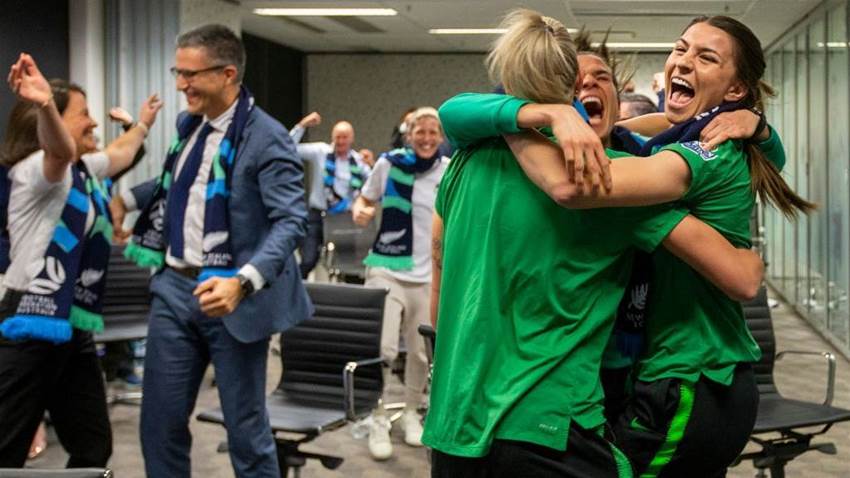This week marks 45 years since the 1975 Australian XI, a team from NSW who were endorsed by the Australian Soccer Federation, played in the 1975 AFC Women's Championships.
That legendary team captained by FFA Hall of Famer Pat O'Connor, were a world away from Collective Bargaining Agreements (CBA's) and professional playing contracts, with the players raising funds for nearly two years to be able to participate in the first ever Asian continental international women's tournament.
The players took part in lamington drives, car washes, raffles and even rattling tins on the street just so they could represent Australia. The competition now known as the Asian Cup was won by the Matildas in 2010.
Fast forward to 2020 and life is very different from 1975 for our best women footballers.
The PFA have confirmed the Matildas were paid their full base salaries in their last contract period from 1 August 2019 to 31 July 2020, this is despite the Covid19 pandemic that has had a major financial impact on football. Work is currently underway to finalise what national team revenues are available within the next 12 months in the wake of FFA's revenue dropping significantly due to the impact of Covid19.
The PFA confirmed the Matildas are required to have a minimum of 18 players who are contracted to FFA each year. The 2019/20 period had 20 contracted Matildas. There are now 21 contracted for the 2020/21 period.
The funding of both the Matildas and Socceroos pay stems from a historic National Team Generated Revenue share fund that was signed by the FFA and PFA last November.
This fund includes income received from broadcast rights, team sponsorship, merchandise and licensing, ticket sales, grants from governments to host matches and other payments that stem directly from players.
Of this total revenue, the players are allocated 24% of which 19% is allocated to senior players with a further 5% allocated to youth national teams. By the end of the current CBA agreement, this 19% will increase by 1% each year to 22% by 2023.
The Matildas and Socceroos split this revenue equally, which provides their salaries. The main difference between the Matildas and Socceroos is the female players are guaranteed a fixed annual salary on their centralised contract, with their total remuneration increasing based on performances, prize money and other commercial incentives.
The Matildas contracts are divided into three tiers, with 11 players in the top tier. The top tier players received a base salary of $83,771 in 2019/20, which correlates with the maximum amount a Socceroos player is allowed to get each season. A second tier player received $56,000 in the last pay cycle, while a third tier player received $40,000 at least.
On top of these salaries, the National Team Generated Revenue fund will also fund Matildas match payments, win bonuses and tournament bonuses. Non-contracted Matilda players receive daily allowances which is also paid from this centralised fund.
The Socceroos aren't guaranteed a salary but receive appearance fees and bonuses.
The head coach and two other FFA officials determine which Matildas get contracts, with the player's status as a footballer a key element of the decision. This includes performances, experience and the level of club football they are playing in.
The base salaries are then topped up with prize money allocated from the various tournaments the Matildas appear in. The players share of prize money is at least 40% for a World Cup (50% if they progress into the knockout rounds), 33% for the Asian Cup (for Socceroos only currently) and 33% for any other tournament. The players themselves then decide how this money is distributed to each other.
With two Olympic Games (Tokyo 2021 and Paris 2024) book ending the 2022 Asian Cup, the 2023 World Cup in Australia and a number of other tournaments in the next four years, the pay day that women footballers have been dreaming for so long is now a reality.
The players are also guaranteed top class travel comforts including business class flights and 5-star accommodation. Although the current financial climate in the wake of Covid19, may mean the players need to be flexible with this.
FFA have received widespread plaudits for not reducing the Matildas salaries from March 2020 to July 2020, despite the $43.5M shortfall in revenue the national governing body has experienced due to a restructured broadcast deal with Foxtel and the loss of major sponsors.
While not without its detractors in the women's game - with raising wages for W-League players of particular concern - the investment in the Matildas by FFA is seen by most as an example of women's football in Australia moving forward.
Names like Sam Kerr, Ellie Carpenter, Lydia Williams and Steph Catley are becoming household names now and many feel it is about time these women were paid well for the work they put in to be the best players in the world.
It's worth remembering though, it all started with Pat O'Connor (captain), Christel Abenthum, Gundy Zarins, Lynn Everett Miller, Kim Coates, Julie Dolan, Cindy Heydon, Stacey Tracy, Sue Larsen, Sue Taylor, Lynn McKenzie, Connie Selby, Sue Binnes, Trudy Fischer, Vicky Kohen and Trixie Tagg...the legends of 1975.
Related Articles

'Timing not right': Montemurro's verdict on Matildas vacancy

Matildas: 'Fourth at the Olympics is honestly the worst place you could come'
.jpg&h=172&w=306&c=1&s=1)












